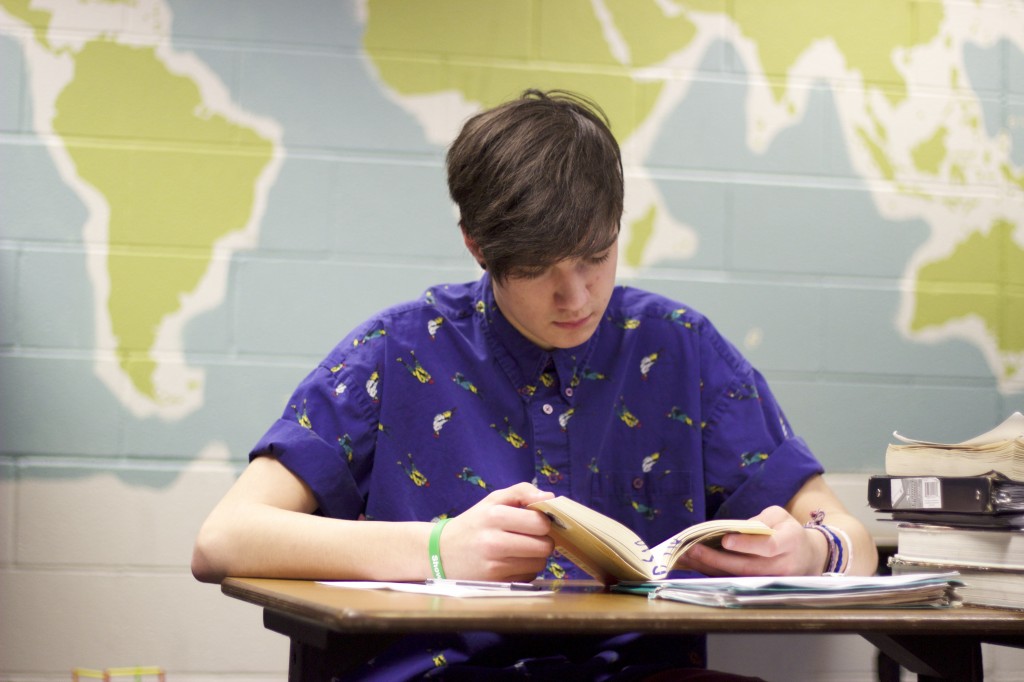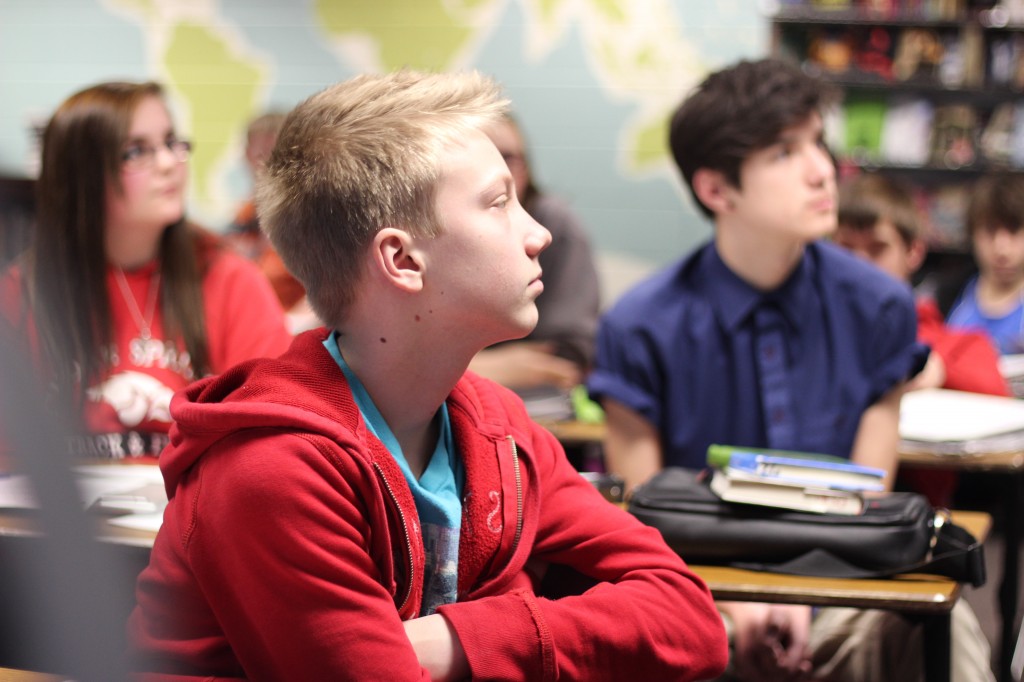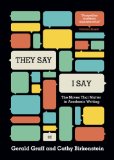
Full disclaimer: I’m the kid who got cut from soccer his junior year of high school and hasn’t really played organized sports since. And even though I’ve got my alma mater tattooed on my thigh (the picture at right should explain that a bit), I watch, at most, one or two full sporting events per month. (Except in March.)
In short, I’m no sports junkie.
With that being said, I’ve found that sports-related metaphors can be a key for moving my students to work harder and smarter on challenging literacy tasks, whether they be Common Core or otherwise. Below, you’ll find three metaphors that have helped my students own their education and practice not only reading, writing, speaking, and listening, but also grit, self-control, and optimism. In other words, these metaphors are one additional piece that makes the non-freaked out approach feasible.
1. Welcome to Spartak

At the beginning of every school year, my freshmen Comp and Lit students read excerpts of Daniel Coyle’s piece for the New York Times, “How to Grow a Super-Athlete.” The article explores the science around a fatty substance called myelin — a substance so significant that Coyle claims myelin is essentially talent itself. Here’s how it works: when specific neural pathways are used repeatedly — say, the pathway used when serving a tennis ball — a myelin sheath forms around the pathway, and this sheath acts like the rubber coating around an electrical cord. The result is an insulating effect; when neural signals are sent along heavily myelinated pathways, they are significantly faster and stronger than those sent along non-myelinated paths.
To illustrate the power of myelination, Coyle travels to a breeding ground of world-renowned tennis players: the Spartak Tennis Club in Moscow. Coyle shows how the children at Spartak become expert tennis players by focusing on technique and receiving “constant critical feedback” from a teacher who is “focus[ed] ruthlessly on improving weakness.”
Intense, right? But the results are intense, too: Spartak regularly produces a large percentage of Russia’s (and the world’s) best tennis players. According to Coyle, this is because Spartak has unknowingly tapped into the way myelin is developed in our nervous systems.
So back in my high school classroom, my students anticipate Coyle’s article by answering whether they believe talent is inborn, developed, or both. Then, they closely read the text, annotating points in the article where they find information that supports, refutes, or muddies the stance they took prior to reading.
After the reading, I ask students, “According to Coyle, is talent inborn, developed, or both?” I have them discuss their answers in pairs, and then we have a brief discussion. When we’re through, I ask my students a series of “True or False and Why” questions; here’s an abbreviated version of how the discussion progresses:
- Me: “The children of Moscow are born better at tennis than children anywhere else.”
- Them: “False! They are simply born in close proximity to a tennis club that unknowingly specializes in myelinating its players’ tennis-related neural pathways.”
- Me: “The secret to becoming great at something is doing a lot of it.”
- Them: “Sort of. Coyle talks about how the key to myelinating isn’t just doing something repeatedly, it’s doing something with constant critical feedback and a desire for improving weaknesses.”
Once we’ve had some good dialogue, I close with something like this:
Students, this year in English class you will enter the Spartak of reading, writing, speaking, and being successful people — every day. Come ready to work hard like Spartak students, get critical feedback from me like that given by Spartak coaches, and become excellent at the core skills of a flourishing life.
This may not be a magical speech like in the movies, inspiring the underdogs to go out and immediately dominate the favored opponent, but it does begin a metaphor that we’ll carry all year long and that I’ll use to motivate students when the reading gets hard or the writing gets frustrating.
From now on, English class will be Spartak.
2. You’re living inside the montage, not watching it
You know those scenes in every sports movie where the protagonist goes into intense training for a few minutes while a sweet song jams in the background? Perhaps one of the most famous is Rocky running up those steps in Philly, rocking his gray sweatsuit while the theme song boldly foretells his impending glory (just search Youtube for a Rocky montage; you're welcome).
I show one of these montage clips (there are hundreds freely available on YouTube from any movie you can think of) to my students and ask them to discuss what the film is portraying. When we come back as a group, I call on some students randomly, aiming to get us to a point where the students say that a montage like this represents the passage of a long period of time, and during that time the protagonist is intensely training.
I then make an arguable claim with my students. I tell them that the majority of teenagers in the USA have watched too many sports movies and are unable to properly “read” them; essentially, they believe that the montage scenes are literal, and that, if they’ll just work hard for a few minutes, earbuds blasting in their ears, they’ll be ready for the reading and writing demands of college/career. Because of this, modern teens are in for a quick knockout when they enter the ring of postsecondary life.
At these claims, some of my students are a bit perturbed, and I invite their arguments and allow students to debate for a few minutes. They will quickly clarify that I’m speaking figuratively. I don’t think teenagers literally misunderstand that montage scenes represent a long period of hard work. Instead, I do think most teenagers believe they need not work hard to prepare to live flourishing lives.
The point of this discussion is severalfold. In the immediate sense, my students have closely read a film, identified the use of figurative language in an argument, and spent time arguing amongst themselves — all good work in the pursuit of a robust literacy skillset.
But in the longer sense, we’ve developed another key metaphor we’ll frequently refer to throughout the course of the year: the montage mirage. I want my students to see that they are inside of the montage of their lives, not watching it, and toward that end our year will be infused with phrases like “Challenging Reading Task X is part of the montage” or “Sure, Process-Written Paper Y will be simple — and Rocky only worked out for three minutes to prepare for Apollo Creed!”
3. “Jacket on, jacket off”
(I've discussed this one elsewhere on the blog, too.)
My freshmen students owe a huge debt of gratitude, along with hundreds of thousands of other secondary and postsecondary students, to Gerald Graff and Cathy Birkenstein for their work with argumentative sentence templates in They Say / I Say: Moves that Matter in Academic Writing (and there's a new edition out, by the way — check it out by clicking on the book to the right).
Yet, inevitably, by about mid-year, when I tell my students to employ Graff/Birkenstein's helpful writing templates in their writing for the hundredth time, I’ll hear some groans. When this happens, I smile. It’s time for The Karate Kid.
In the 2010 film (not to be confused with the 1984 version), the protagonist is a kid named Dre (Jaden Smith), and he keeps getting beat up by bullies. Eventually, he enlists the help of a kung fu teacher, Mr. Han (Jackie Chan). But when Dre comes to Mr. Han’s house to begin learning how to beat up those bullies, Han simply tells Dre to take off his jacket, hang it on a hook, take it off the hook, put it back on, over and over and over again.
After days of this, Dre becomes frustrated. He, like my students, groans at what seems to be a pointlessly repetitive exercise. As he’s about to quit, Han shows Dre how repeating those jacket movements countless times has essentially given the young trainee a small but effective set of myelinated kung fu motions. He has so internalized them, in fact, that he instinctively employs them to ward off a sophisticated attack by Han. Basically, without knowing it, Dre has developed the core skills of kung fu through some seemingly mundane, repetitive tasks and movements (along with some critical feedback along the way from Han).
I show this clip to my students (I found a portion of it on YouTube; it should be embedded above, but just in case, click here), and then I tell them that, every time they use a sentence template to organize their thinking, they are putting the jacket on and taking it off. However, simply stopping here wouldn’t be as powerful as showing them how far they’ve come, so I play a clip from their first in-class debate of the school year. I then have them compare that to their performance in a more recent debate, excerpts of which we also watch. They always notice how much more connected and fluid their thoughts are — thanks, they realize, almost entirely to the generative power of Graff and Birkenstein’s templates.
Seeing them come to this realization is a pretty powerful moment every year, and once again, I use the “jacket on, jacket off” metaphor to motivate them to do the hard work of trusting the process, applying themselves, and entering into the deep practice that myelination requires with every text we read and write and discuss.
(By the way, thank you to Jerry Graff for sharing this article, in which Stanley Fish also uses a Karate Kid analogy to great effect!)
Our Classroom Sport is Called Life Domination
As a not-to-sportsy dude, I happily draw on metaphors from the realms of athletes because, at the end of the day, I want my students to live lives that flourish, no matter which path they pursue. And while they don’t all resonate with me saying “This is Spartak” or “Put on the jacket” or “You’re in the montage,” enough of them come to own these metaphors, using them in their own daily talk. They begin to look forward to class and, odd as it may sound, they start enjoying texts and writing assignments that will challenge them — even texts and assignments that are not of their choosing.
But my goal here is not simply that they’ll like my class or be engaged while in it — it’s that they’ll own their education. As freshmen in high school, they all have a chance to make just about whatever they want of their lives, but if they’re not careful, mistakes in ninth grade can begin to delete options from their future pretty quickly.
My goal with these metaphors, then, is to help them see that they need not rule anything out yet; though many of them haven’t decided what postsecondary paths they’ll ultimately pursue, I want them to understand the value of being hard-working people who relentlessly improve their literacy skillsets.
Why? Because as I tell them, we are a team in a game called Life Domination. The game is huge, complex, and dangerous. It's also intensely rewarding.
And I want them to win.


Amy Kinseth says
Dave, I love reading your posts. You are so funny, and I have to assume your students love you. As an elementary teacher, I can’t employ everything you use in your classroom, but I can (and have) interpret and amend some of your ideas for my little ones. I love these idea as a beginning of the year hook for the kids. The sports analogy is one my 4th graders can gleam onto, too. I’m totally going to start next year like this. Thanks for the ideas!!
davestuartjr says
Amy, what an encouragement to wake up this morning to read your comment. My students and I enjoy our journey together most of the time — I won’t say we’re perfect!
I love your solution-oriented approach, Amy — I count it a privilege to have readers who teach elementary school and yet still find use with what I write. Please let me know how it goes next year! 🙂
Wendy Heyd says
Dave – I always find your posts insightful and a delight to read. I’d love to go back 40 years and be a student in your class! I am a resource teacher (elementary certified) and currently not in a position to put into practice your ideas, however I share them enthusiastically with curriculum coordinators with whom I work. You are going great stuff…thanks for leading the charge!
davestuartjr says
Wendy, so kind! One reason I enjoy teaching is because every day I have a chance to aggressively and productively fail — I am always making mistakes and learning from them. My students are very gracious, as you are! Please let me know if there’s ever a topic I can try to tackle in writing that would be helpful for you as a resource teacher or for your curriculum coordinator colleagues. As you’ve likely discovered, I’m far from an expert but I do work hard to try to get to the bottom of things 🙂
Thank you so much, Wendy.
Rachel Wasserman says
I just found your blog, after our former reading coach sent us a link to it. Like everyone else whose responses I’ve read, I love it! I am extremely disappointed that the English Journal did not publish the excellent article you wrote about sports metaphors in the classroom — I HATE sports, but my students love them, and I now plan on incorporating your suggestions in my curricular approach next year. Thanks so much for sharing your fabulous and useful ideas — to me, you’re a natural Teacher of the Year!
davestuartjr says
Rachel, that’s awesome — I was hoping this post would mean something to people who absolutely despise sports and to those who love them. I can at least check off the former category 🙂 So much of our job is showing students why our subjects matters. I can tell that you are great at doing that. Please do let me know how the metaphors go, Rachel — and thank you, again, for your kind kind words.
Diane Mattison-Nottage says
Love this post, truly! I will be “borrowing” these for some adult PD I’m planning. My boss loves sports metaphors and these are perfect for him and the group I’ll be presenting to. Thanks!!!
davestuartjr says
Diane, let me know how your boss likes it AND how they work for the PD you’re working on. I wish you success!
Lisa Love says
I will definitely be using some of your ideas in my classroom. I am a 4th grade teacher who enjoys sports and uses sports metaphors often in the classroom. Many of my students come into my class not comfortable academically but most are good at sports. At the beginning of the year I point out that when you play organized sports the time you spend actually playing the game is a fraction of the time you spend learning how to play and developing your skills.However, the better your skills are the more you enjoy the game. Also, that you have to challenge yourself for your skills to improve. We try to celebrate our successes and our failures as a team. Thank you for giving me something extra to use to motivate my kids.
pdexiii says
First of all, Go Blue (’84, B.S.E., Aero).
Second, more of a sports reference-analogy I use: When football players are in the huddle, all the eyes are tracking the quarterback (speaker), and when words are spoken they must be heard and comprehended the first time. You cannot raise your hand and say, “I don’t get it,” and you must REMEMBER and execute instinctively what was communicated.
This analogy always gets the boys attention especially, and establishes an expectation of effort they understand.
davestuartjr says
Go blue is right! I love that analogy — I appreciate how clearly it communicates the need to exert effort in paying close, close attention and then executing what was communicated. So much of our job as teachers is simply explaining in a way our students will deeply understand — that analogy fits the bill for that! Thank you for sharing it 🙂
Holly Stephens says
I agree that sports metaphors often speak to students who may excel, or at least be more confident, on the field rather than in the classroom, and I love pdexiii’s “QB in the huddle” metaphor. Dave, can you share your excerpted Coyle article? I just read _The Little Book of Talent_ and took notes on every chapter – thanks for that idea, too!
davestuartjr says
Here it is my friend: http://davestuartjr.com/wp-content/uploads/2018/06/Article-2-How-to-Grow-a-Super-Athlete.doc